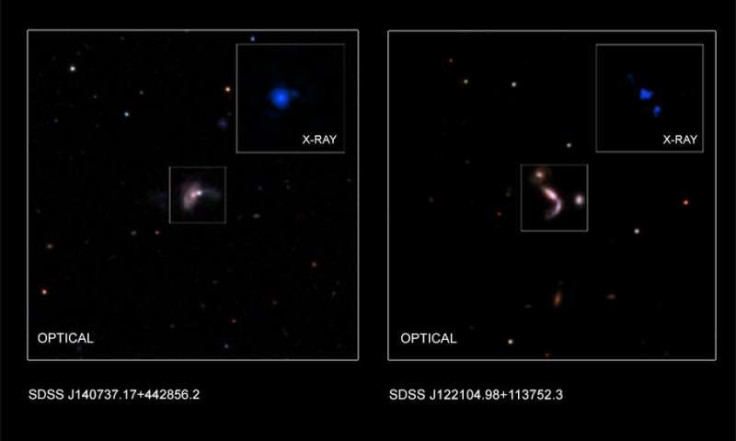When Galaxies Collide: Astronomers Locate Five Extremely Elusive Supermassive Black Hole Pairs

Astronomers have identified five new dual supermassive black holes, which they say could help us understand the way these giant entities grow and how they generate the strongest gravitational wave signals in the universe.
These supermassive black hole couples, each containing millions of times the mass of the sun, are formed when two galaxies collide, bringing the black hole in each galaxy close to one other.
Data from NASA's Chandra X-ray Observatory, the Wide-Field Infrared Sky Explorer Survey (WISE), and the ground-based Large Binocular Telescope in Arizona was used to observe the five pairs.
"Astronomers find single supermassive black holes all over the universe," said Shobita Satyapal, leader of a paper on the findings from George Mason University, Virginia, in a Phys.org report.
"But even though we've predicted they grow rapidly when they are interacting, growing dual supermassive black holes have been difficult to find," she said.
Locations of 10 such pairs had been approximated before with the help of X-ray studies. But, these were more of a prediction of locations, and to carefully pinpoint their position, astronomers had to use data from multiple telescopes capable of detecting different wavelengths of light.
Sloan Digital Sky Survey (SDSS) provided the data to identify galaxies which were a result of two smaller galaxies colliding.
They selected systems where the centers of the two galaxies appeared closest to each other. The distance was set at 30,000 light years and any difference above that meant the system was rejected.
The SDSS data coupled with WISE infrared data, helped the astronomers predict the location of these rapidly growing supermassive black hole pairs.
This was because these growing black hole pairs tend to radiate a lot of X-rays. When observed with Chandra Observatory, five systems were spotted matching the distance criteria and also displaying high X-ray readings.
This proved to be evidence enough to accurately zero in on these colliding galaxies to study their dual supermassive black holes.
The team said their study, published in the Astrophysics Journal, shows that combining the infrared data obtained from WISE and the X-ray study to identify the growing systems is an efficient method for any future detection of similar developments in space.
According to Sara Ellison, lead author of another paper on these findings from the University of Victoria in Canada, "X-rays and infrared radiation are able to penetrate the obscuring clouds of gas and dust surrounding these black hole pairs, and Chandra's sharp vision is needed to separate them".
This paper also used optical data from Mapping Nearby Galaxies at Apache Point Observatory (MaNGA) survey to exactly pinpoint the location of one of these pairs which are giving off strongest X-ray readings on Chandra, said the Phys.org report.
When these black holes eventually meet, millions of years later, they will form one giant black hole which will produce a huge amount of gravitational waves.
The identification of these pairs will also help us understand the gravitational waves they emit, providing interesting insight into the study of black holes. The team hopes that the identification method will help astronomers find many such merging systems, helping them identify how common galaxy collisions are.
© Copyright IBTimes 2024. All rights reserved.





















